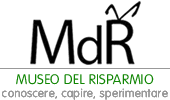The Museum of Saving is committed to raising the level of financial education of students of all grades, offering educational visits focused on specific economic subjects. The guided visits are tailored to the age and school level, and are conceived to allow students to understand complex concepts in an innovative and pleasant way.
Contents, available in Italian and in English, are proposed through:
– 3d videos, cartoons
– historical reconstructions
– interviews of experts
– video clips
– documentaries
– theater animations
– role plays and applications to test saving capabilities.
The different support materials allow the visit to be tailored to personal requirements.
Primary School
- History and role of Money
This visit is aimed at the discovery of the history of money and its key players, from the earliest forms of bartering in the ancient Egypt to the introduction of the Euro. Through videos and digital applications, students can understand the function of money and its evolution during different historical periods.
- Role and importance of saving
In this visit primary school students can understand the relationship between the concept of scarcity of resources and the need to save. The lack of financial resources to realize our desires represents one of the main motivations to save.
Middle School
- From money to the bank account
This educational tour offers a historical trip from the origins of money to the introduction of the bank account. Students can understand the function of money and its evolution and learn how to read a bank statement.
- The Florentine bankers
This visit is focused on the role of patronage during the Italian Renaissance, an era where arts and sciences had an impressive development. At that time, the rich Florentine bankers were used to investing part of their wealth to support artists and scholars.
- The speculative bubbles
Stepping from the famous “tulip-mania” of the 17th century to the recent “dot-com bubble”, students are invited to consider the issue of speculative bubbles with a special attention to the individual behaviors which cause them.
High School
- History and role of Money
This visit allows to discover the history of money and its key players. Through videos and digital applications, students can understand the function of money and its evolution during different historical periods.
- Financial crises
The focus of this visit is on the mechanisms which lie behind financial crises, the link between the financial and real economy, the role of trust and mistrust in financial markets and the importance of regulating the financial sector.
- Entrepreneurship
Through testimonies of successful entrepreneurs and videos explaining how to finance the start up and growth of companies, students will understand the fundamentals of entrepreneurship.
- Financial instruments
The main financial instruments (e.g. shares, bonds, derivatives,..) and the basic financial concepts (e.g. the risk-return relationship) are explained in an amusing and entertaining way, enabling students to understand their role and functioning in the markets.
- Social security
This tour addresses the issues of insurance and social security in order to illustrate the concept of “risk-sharing”, the reasons to set up a system of protection for businesses and workers and the functioning of the Italian welfare system.
- Risk and Insurance
This guided tour analyzes the concept of risk in its various facets, in everyday life as well as in finance, and illustrates hedging strategies and instruments, starting from insurance to reach diversification, both at theoretical level and in practical application.
- Ideas and Innovation
This tour emphasizes the concepts of human capital and investment. Through interviews with startuppers and entrepreneurs, students will get an overview of the world of innovative companies, and will be brought closer to the complex reality of business management through a business plan tutorial and a specific videogame.
- The good side of finance
Thanks to a series of interviews with economists, “third sector” volunteers and entrepreneurs, this visit aims to highlight how finance can have positive and ethical connotations and implications, in contrast with what seems to emerge from certain news and certain successful films.
- The role of financial institutions
Following common thread that spans the centuries, the visit shows the birth and development of the banking activity, starting with the granting of credit in Ancient Rome, passing through Florence in the Renaissance, to arrive at modern commercial banks. The scenario is complemented by an analysis of the role of central banks and multilateral institutions.
